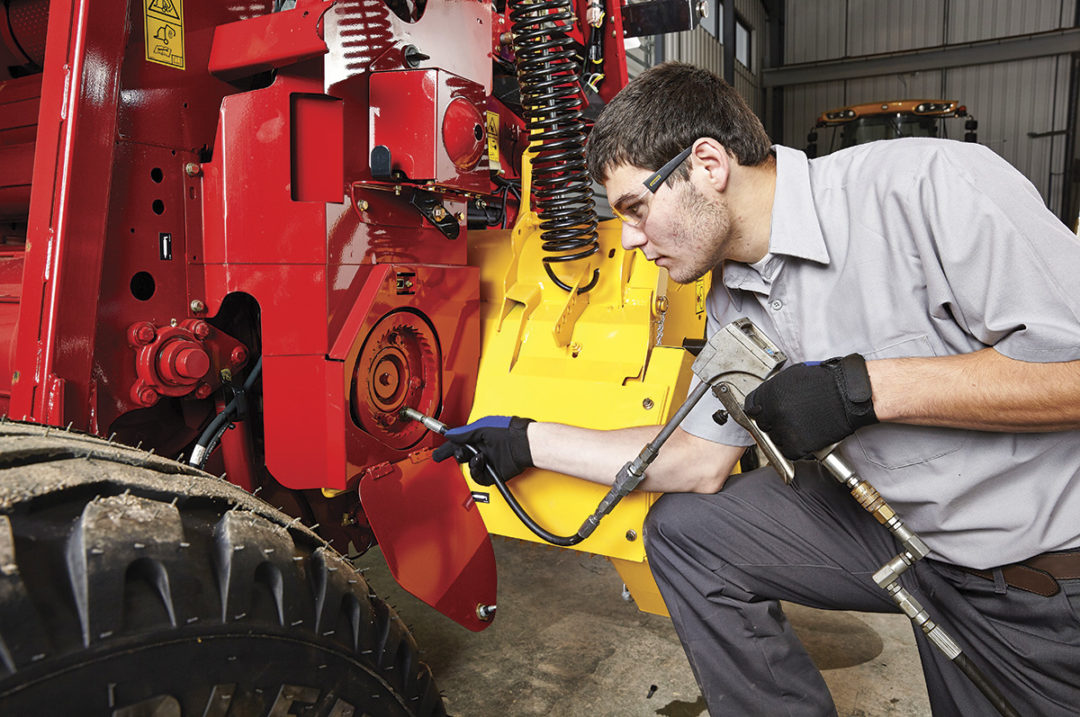Let’s go back to the basics of farm equipment maintenance. In today’s world, farmers are focused on the future of their operation – adding technology, considering autonomy or just looking at the next, new-to-them tractor that will increase efficiency. At the end of the day, no piece of equipment is going to properly perform in the field without a good maintenance routine, and any good maintenance routine includes frequent greasing.
Grease is a common find in shops, tractor cabs or pickup trucks as a go-to lubricant for regular use. Applied to a number of grease zerk fittings found near moving parts or where friction may occur, grease acts as a protective barrier, lubricating agent and safeguard against wear and tear. However, have you considered why you use grease instead of oil, the difference in grease types or why grease selection can be important to equipment performance? Not all grease is made equal or intended for the same purpose. Let’s dive into the details.
Grease or oil?
While both are lubricants, grease and oil serve different purposes for different parts, all with an end goal of preventing friction and excessive wear. Grease is an oil-based, thickened lubricant composed of three main elements: base oil, thickener and additives. The oil base does the lubricating, while added thickener immobilizes the base. Additives, ranging from antioxidants to friction modifiers, combine to enhance performance and effectiveness.
Compared to oil, grease stays where you put it without dripping, leaking or splattering due to its thickness, which decreases the frequency of repeat application. Grease seals out contaminants like dirt, chafe or even water to prevent part damage and reduce noise or dampening.
Grease is typically applied to any area of equipment where there may be metal-on-metal contact. Parts like bearings, steering components, ball joints, power takeoff (PTO) shafts and other pivot points will need to be greased regularly. The equipment owner’s manual will identify all the recommended greasing points, as well as ideal greasing intervals.
How to properly apply grease
Applying grease to the recommended greasing points is simple, but there are a few tips to remember for proper application. Using a battery-powered or manual-pump grease gun, securely attach the tip to the zerk and begin applying. The grease will flow through a channel to the cavity or area that needs to be greased. Once grease escapes the area, or there is resistance to application, enough grease has been applied. There is a small captive bearing ball in the fitting that will open and close during application. Occasionally, rust or dirt will prevent the bearing ball from working properly, creating resistance and preventing grease from entering the cavity. Grease zerks can be easily cleaned using a special tool or may require replacement if the fitting continues to reject grease.
Additives for added performance
We have already mentioned the third element of grease: additives. Additives are added to the composition of grease to enhance and maintain a consistent performance or enable protection for a certain use or application. Grease additives may include antioxidants, anti-wear, extreme pressure additives, friction modifiers, dyes, anti-weld and solid lubricants, rust and corrosion inhibitors, tackifiers and polymers, and viscosity index improvers. Each of these enables different properties within the makeup of the grease to provide top protection for the parts it comes in contact with on the equipment.
Other variances in grease may include different thickeners that impact rust prevention or wear properties.
Many grease options on the shelf are labeled as multipurpose for use on all types of equipment, but some are labeled for use in high temperatures, making them ideal for use in extreme operating conditions.
Selecting the best grease
Grease selection may often be made based on price or convenience; however, using a grease that is not recommended by the equipment’s original manufacturer can compromise quality and effectiveness. Selecting a grease that meets the following criteria can maximize effectiveness and protection of critical parts:
- Stays in contact with the moving parts during operation
- No leakage under gravity or centrifugal action
- Resists being squeezed out under pressure
- Maintains shear stability at all temperatures
- Flows from spot to spot in the equipment, if/as needed
- Avoids interference with the power required for startup or operation
Using the original equipment manufacturer (OEM) grease product is ideal for maximum performance of your equipment. OEM grease is an important tool to safeguard a significant investment in machinery. OEM grease options have been tested and approved for top protection and are a cost-effective piece of your equipment maintenance routines to reduce part wear and extend equipment life.
The next time you begin a maintenance routine, remember to reference your owner’s manual for a refresher on the location of all the grease zerks. For more information about the right grease for your fleet, visit the experts at your local equipment dealership.
This article was written on behalf of New Holland Parts & Service.








